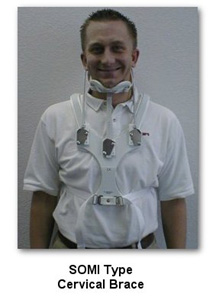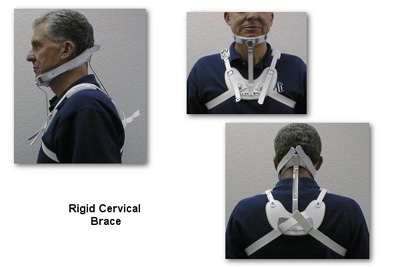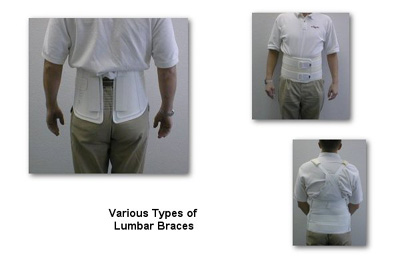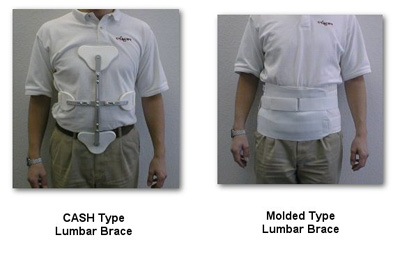Back and Neck Braces

If you are diagnosed with a spinal disorder, deformity, or potential problem that can by helped through the use of external structural support, your physician may recommend the use of a back or neck brace. Braces offer a safe, non-invasive way to prevent future problems or to help you heal from a current condition.
The use of braces is widely accepted. They are effective tools in the treatment of spine disorders. In fact, more than 99% of orthopedic physicians advocate using them.
Braces are really nothing new. They have actually been around for centuries. Lumbosacral corsets (for the lower back) were used as far back as 2000 B.C.! Bandage and splint braces were used in 500 A.D. in an effort to correct scoliosis (a spine with a sideways curve). Recently, braces have become a popular way to actually help prevent primary and secondary lower back pain from ever occurring.
There are more than 30 types of back supports available for spine disorders. This website will discuss several common types and why they are used.
This website will cover:
- Neck Braces
- Trochanteric Belts
- Sacroiliac and Lumbosacral Belts
- Corsets
- Rigid Braces
- Hyperextension Braces
- Molded Jackets
- Lifting Belts
- Clinical Uses
- Goals of Spinal Bracing
- Possible Drawbacks

Neck Braces
Neck braces are used to provide stability of the cervical spine after neck surgery, a trauma to the neck, or as an alternative to surgery. They are probably the type of spinal brace you most commonly see people wearing. There are several types available, including:
Soft Collar - This flexible brace is placed around the neck. It is typically used after a more rigid collar has been worn for the major healing. It is used as a transition to wearing no collar.
Philadelphia Collar - This is a more rigid/stiff collar that has a front and back piece that attaches with Velcro on the sides. It is usually worn 24 hours a day until your physician instructs you to remove it. This collar is used for conditions such as: a relatively stable cervical (upper spine) fracture, cervical fusion surgery, or a cervical strain. Another similar type is the Miami cervical brace.
Sterno-Occipital Mandibular Immobilization Device (SOMI) - A SOMI is a brace that holds your neck in a straight line that matches up with your spine. It offers rigid support to a damaged neck and prevents the head from moving around. With this brace, you are unable to bend or twist your neck. The restriction of motion helps the muscles and bones to heal from injury or surgery.
If you look at what the name means, you will better understand what a SOMI does: "sterno" means your upper and middle chest, "occipital" is the base of your skull, "mandibular" refers to your jaw and chin, and "immobilization" describes the support and movement restriction the brace offers. The SOMI is worn on the parts of the body for which it is named. First, there is a chin piece that the lower jaw rests on. Second, the chin piece connects by straps to a headband that is worn across the forehead. Third, the chin piece connects to a chest piece by a front metal extension. Finally, the chest piece then rests on the upper and middle chest - sort of like a vest. This connects to the occipital piece, which supports the base of the head.
This brace is obviously a bit more complicated and cumbersome than some of the others, but it provides excellent support for an injured neck.
Halo - The main purpose of the halo is to immobilize the head and neck. This is the most rigid of the cervical braces. It is only used after complex cervical spine surgery or if there is an unstable cervical fracture. The halo looks a lot like the word sounds. It has a titanium ring (halo) that goes around your head, secured to the skull by four metal pins. The ring then attaches by four bars to a vest that is worn on the chest. The vest offers the weight to hold the ring and neck steadily in place. The Halo is worn 24 hours a day until the spine injury heals.
Trochanteric Belts
The trochanteric belt is usually prescribed for sacroiliac joint pain or pelvic fractures. The belt fits around the pelvis, between the trochanter (a bony portion below the neck of your thigh bone) and the iliac (pelvis) ridges/crests. It is about five to eight centimeters wide and it buckles in front, just like a regular belt.
Sacroiliac and Lumbosacral Belts
The lumbosacral belt helps to stabilize the lower back. These belts are usually made of heavy cotton reinforced by lightweight stays. The pressure can be adjusted through laces on the side or back of the belt. These belts range in widths between 10 to 15 centimeters, and 20 to 30 centimeters. The sacroiliac belt is used to prevent motion by putting a compressive force on the joints between the hipbone and sacrum (base of the spine).

Corsets
Corsets provide rigidity and support for the back. Corsets can vary in length. A shorter or longer corset will be prescribed, depending upon your condition. A short corset is typically used for low back pain, while a longer one is used for problems in the mid to lower thoracic spine. When people think of corsets, they usually conjure up images of women from earlier centuries who used them to make their waists look smaller. Today, in the treatment of back problems, corsets refer to a type of back brace that extends over the buttocks and is often held up by shoulder straps. Like the corsets of old, these lace up from the back, side, or front. There are metal stays that provide the appropriate rigidity and support for the back.
Rigid Braces
These braces are typically prescribed for low back pain and instability. If greater rigidity is needed to support the spine than can be found in standard back supports, rigid frame spinal bracing is often prescribed. These are stiff braces. They usually consist of rear uprights that contour to the lumbar (lower) spine and pelvis, along with thoracic bands. There are also fabric straps on the braces that provide pressure in the front. Common types of rigid models are:
- Williams Brace - This type of brace has no vertical uprights in the middle so that flexion/bending is allowed.
- Chair-back Brace - This type immobilizes the lumbar spine in the neutral position. The chair-back is designed to reduce sideways and revolving movement of the lower spine.
- Raney Flexion Jacket - This type reduces lumbar lordosis by holding the patient in a neutral tilt.

Hyperextension Braces
This brace is designed to prevent excessive bending, and it is often prescribed to treat frontal compression fractures that have occurred around the junction of the thoracic and lumbar spine. The brace can also be used for post surgery healing from a spinal fusion.
These braces offer support that allows anterior (front) pressure unloading of the thoracic vertebrae by restricting flexion (bending) of the thoracic and lumbar spine.
Hyperextension braces have a front rectangular metal frame that puts pressure over the upper sternum and the pubis/pubic bone. This encourages spinal extension. There is opposing pressure applied over the T-10 level (the tenth vertebra in your thoracic spine). The braces offer what is called "three-point stabilization" to the spine through a front abdominal pad, a chest pad, and a rear pad at the level of the fracture.
By applying pressure in three-points - sternal, pubis and rear Lumbosacral - the spine is extended/stretched. The sternum is the narrow, flat bone in the front middle of thorax. The thorax is the portion of body between the base of the neck and the lower diaphragm.
The most common types of Hyperextension Braces are Knight Taylor and Jewett.
Molded Jackets
These jackets are designed to distribute pressure widely over a large area. By immobilizing the patient from the neck to the hips, pressure is distributed evenly, taking excess pressure off overloaded or unstable areas. These jackets were originally made of plaster of Paris, but now are typically made out of molded plastic.
Lifting Belts
These belts are designed to reduce low back strain and muscle fatigue that can occur when you are lifting heavy objects. The belt circles around the waist, covering the lumbar region of the spine, and closes in front. These belts are usually made of cloth or canvas and do not have stays. Some models also have lordosis pads.
Clinical Uses
The braces/supports are most frequently used to treat: low back pain, trauma, infections, muscular weakness, neck conditions, and osteoporosis. Braces, belts, and jackets are designed to immobilize and support the spine when there is a condition that needs to be treated. Depending on the model that is used, they can put the spine in a: neutral, upright, hyper-extended, flexed, or lateral-flexed position.
Goals of Spinal Bracing
Spinal bracing is used for a variety of reasons such as to: control pain, lessen the chance of further injury, allow healing to take place, compensate for muscle weakness, or prevent or correct a deformity. More specifically, lumbar corsets and braces compress the abdomen, which increases the intra-abdominal pressure. This act allows pressure on the vertebral column to unload, providing some relief.
There are other reasons bracing is used. One is the theory that they insulate the skin, producing increased warmth that decreases the sensation of pain - much like a heating pad. Another reason is that the increase in abdominal pressure produces hydraulic support for the back. Finally, certain types of movement may cause stress to the pain generators in the back. The decrease in range of movement by using bracing may relieve this type of pain.
Possible Drawbacks
Though the effects of bracing are primarily positive, they can lead to a loss of muscle function, due to inactivity. Bracing can sometimes lead to psychological addiction, so that even when the patient is healed and ready to be taken off the back brace, he or she feels dependent upon it for physical support.
